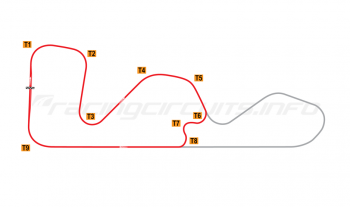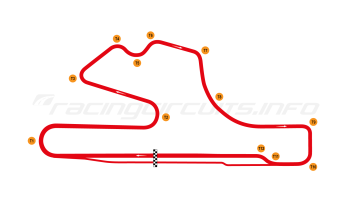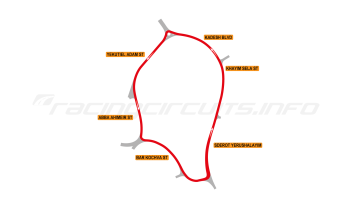Tacoma Dome
Circuit Overview
With the promise of “racing so hot it will singe your socks” (at least according to the event programme!) the Tacoma Grand Prix was held twice in 1986 and 1987 on a temporary street course encircling the Tacoma Dome.
Featuring the NASCAR Winston West NASCAR 200K Race as its main event (making it the first NASCAR-sanctioned race on a street course, well before Chicago!), the festival of speed also included races for Formula Atlantic , SCCA Sports 2000 racers, vintage cars and the Formula Russell junior single seaters.
Despite a roster of famous names including Al Unser, Sir Jack Brabham, Parnelli Jones, Bob Bondurant and NASCAR drivers Chad Little, Derrike Cope and Hershel McGriff taking part, the event faded away after just two runnings.
Circuit History
The idea for a street race around Tacoma, Washington, began in a small county store in Rosedale, just north of the city. Riley Hopkins - a Formula Atlantic racer and screen printing impresario - was refuelling his Rover V8 when an exotic car pulled alongside. The two drivers began to chat about their shared passion for cars and Hopkins’ racing exploits.
The other driver told Hopkins he was involved with the Tacoma Athletic Commission which raised money for various athletic non-profit events. Hopkins revealed he had a similar idea to have a non-profit group of businessmen promote racing in Tacoma with all net proceeds going to charities.
The kernel of an idea had been sewn, and by April of 1985, Hopkins and his friend Mark McClure were in front of Tacoma Mayor Doug Sutherland proposing a fundraising street race around the Tacoma Dome. Mayor Sutherland liked the idea and the Tacoma Grand Prix Association, a non-profit corporation, was born.
Putting the plan into action
Ron Mikulski learned of the event through a friend of McClure's. Mikulski, a Seattle advertising executive, was working with Seafair at the time, but after a series of meetings he joined the Grand Prix Association full time as Marketing Manager. Jim Willers, well known in Tacoma as Director of the Tacoma Visitor and Convention Bureau as well as having held other city positions, accepted the responsibility as full time president. Dan Bariault was named association attorney and corporate secretary and was elected to the board of directors.
An advisory committee was formed of prominent Tacoma businessmen consisting of John Wallerich, chairman; Gene Dieken, Stan Naccarato, Gerald Parker, Frank Pupo, Tom Blackhaller of San Francisco and Dan Tutt of Shuck's Auto Supply.

A major sponsor was necessary, so McClure approached several companies until Schuck's Auto Supply recognised the benefit of such an event and agreed to become the main sponsor. The Weyerhauser Company also joined shortly thereafter and the organisation of the First Annual Schuck's Tacoma Grand Prix was underway.
Large amounts of financing were required for the tremendous start-up costs. City street paving would cost $330,000 with the Grand Prix being responsible for $175,000. Thanks to Schuck's and their willingness to guarantee that amount, paving began. Barriers to cover both sides of the race course were also needed at a cost of $315,000. WSW Leasing Co., a local firm, purchased the barriers and agreed to lease them to the Association.
Other major financing was required as the race dates approached. Puget Sound Bancorp led the way in arranging those needs, plus many other businesses and banks joined in as supporters in a variety of ways to support and assist the Association.
A lap of the course

The track was centred around the Tacoma Dome, which had opened a couple of years previously as a multi-purpose indoor arena. It formed the venue for the paddock, with a pit lane and start-finish straight on D Street. Running anti-clockwise, the course headed left along Brotman Way towards Turn 2, a chicane, before turning into one of the Tacoma Dome parking lots, which provided two 90-corners in front of grandstands, before another 90-degree right hander took the cars down F Street.
At the junction with East 25th Street, the cars turned right onto the curving section leading under the railway line to East 26th Street, which formed the longest straight on the circuit. The cars would barrel down the road at speeds of up to 160mph before turning left onto A Street, then quickly left again back onto East 25th Street for a shorter blast upto the final 90 degree right hander, which lead back onto D Street and back to the start/finish.

A 1.5 miles in total length, it was a relatively short blast around the streets, but was characterised with some reasonable elevation changes, with the run along D Street up to the Tacoma Dome in particular featuring an uphill gradient. The race headquarters were located at the Tac Dome Hotel (today the Comfort Inn & Suites), while there was also a free motorsports exhibition at the Tacoma Dome for racegoers to enjoy.
First race attracts the stars
The first Tacoma Grand Prix was scheduled for August 8-10, 1986 and promised a full programme of racing. As was perhaps inevitable with Hopkins as the race organiser, a Formula Atlantic race was among the star attractions for the single seat brigade, with Tacoma forming the seventh round of the West Coast Atlantic Series. Among the young hot shoes lining up alongside Hopkins to compete for the Coca-Cola Atlantic Cup were future Indycar drivers Darin Brassfield and Ted Prappas.
The headline event, perhaps surprisingly, was a NASCAR Winston West series round, marking the first foray onto the streets for the stock car racers. While by necessity the West series had featured numerous road courses on its roster due to the relative paucity of suitable ovals on the West Coast, the decision to race a street circuit was certainly a foray into the unknown and quite a coup for the Tacoma organisers.
There was method in the madness however; NASCAR had been evaluating street racing for some time as it looked for a potential replacement for the soon to be redeveloped Riverside Raceway in California. While these plans included the development a ‘left and right’ road course turn car and ultimately came to nought, the Tacoma race offered a good test run for the concept.
While a number of rungs down from the main Cup Series, the Winston West series nevertheless attracting a strong field, including veteran Hershel McGriff, Derrick Cope, Chad Little and defending series champion Jim Robinson.
The undercard featured a good mix including SSCA Sports 2000 racers, while the Formula Russell Pro Series saw future stars Johnny O’Connell and Jeff Krosnoff competing, alongside racer-turned-commentator Jon Beekhuis. Meanwhile the Ranier Vintage Classic offered a field of classic racers, with event Grand Marshall Bobby Unser the most notable participant, alongside his duties calling the action for TV in the Formula Atlantic and NASCAR races.

In the Formula Atlantic event, Tom Philips of Portland took pole and the victory, from Dan Marvin and Rod Bennett, all in Ralt RT4s. Hopkins finished in 8th, last of the lead-lap runners. The 83-lap feature race saw Derrike Cope start from the pole in a Ford, leading 52 laps but ceding the lead to second-place starter Ruben Garcia’s Chevrolet, only for drive line failure to put him out on lap 32. Hershel McGriff took over at the front and remained there to the chequered flag, taking the inaugural NASCAR street race win for Pontiac.
An estimated 36,500 turned out over three days to watch the races, which raised some $25,000 for local charities. All in all, it proved the success of the event and plans were soon under way for the 1987 race.

Second year sees expanded race card
One of the main gripes of the paying spectators was the difficulty of seeing the action over the concrete barriers. As a result the grandstands were further elevated for year two, while better access and more parking was provided around the course. Minor changes to the track itself included widening pit row lane to give more room during pit stops and a widened exit at Turn One. A small changes was also made to bevel the inside of the corner at Turn 3.
The race card was again headed by the NASCAR races, supported once more by the Formula Atlantic and Formula Russell Pro Series racers. The race for old timer sports cars also returned, while a popular new addition was a Vintage Formula One race, replete with drivers including Bobby Unser, Sir Jack Brabham, Bob Bondurant, Pete Lovely and Parnelli Jones. Sports 2000 and the National Sports Sedan Championship (another newcomer for 1987) completed the schedule.
In the Formula Atlantic race, Johnny O’Connell dominated from pole position, beating out Chris Smith and a quality field which included Ted Prappas and Dean Hall, in third and fourth respectively, with Jon Beekhuis, Parker Johnstone and David Brabham rounding out the top seven places. Riley Hopkins was unable to finish the race, having suffered a broken gearbox.
In the NASCAR race, Hershel McGriff was unable to repeat his success, despite a front row start and leading 13 laps. After various problems he finished six laps down and ninth overall. Instead, it was Chad Little who would wind out the winner, beating Sumner McKnight and pole-sitter Glen Steurer.
Again the race had seemed a success and the event programme had optimistically announced the third running would take place on July 29-31 1988. However, the NASCAR bosses elected not to add Tacoma to the Winston West schedule and other hoped-for replacement headline events could not be found. With that, the race was cancelled, never to return.
Happily, the general area at least retains its links with car culture, thanks to the America's Car Museum which opened in 2012 on East D Street, opposite the area where the start and finish for the Grand Prix was located. It houses part of the world's largest private car collection, which was amassed by Tacoma businessman Harold LeMay.
Circuit info
This is a historic circuit which is no longer in operation.
Rate This Circuit
Votes: 1053
Location Information
Today there’s little evidence of the race ever having taken place and with development in the area in the intervening years, little chance of it being resurrected. The extension of the Tacoma Link tramway along East 25th Street would render it unsuitable for racing, while the section of A Street which linked it with East 26th Street was removed altogether when a railway line extension was added. It is now a pedestrian walkway.
Get your race tickets!
Brought to you with: 
We've teamed up with Motorsports Tickets to bring you the best deals for Formula One, MotoGP, Le Mans and more.









